
-
Find the right food for your petTake this quiz to see which food may be the best for your furry friend.Find the right food for your petTake this quiz to see which food may be the best for your furry friend.Featured products
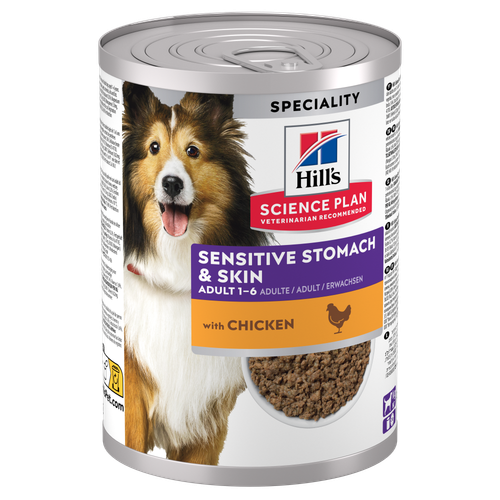 Sensitive Stomach & Skin Dog Food
Sensitive Stomach & Skin Dog FoodHill's Science Plan Sensitive Stomach & Skin Adult Wet Dog Food with Chicken is a complete premium dog food for adult dogs from 1 year. This savoury tinned loaf is enriched with ingredients that support digestive health & skin care.
Shop Now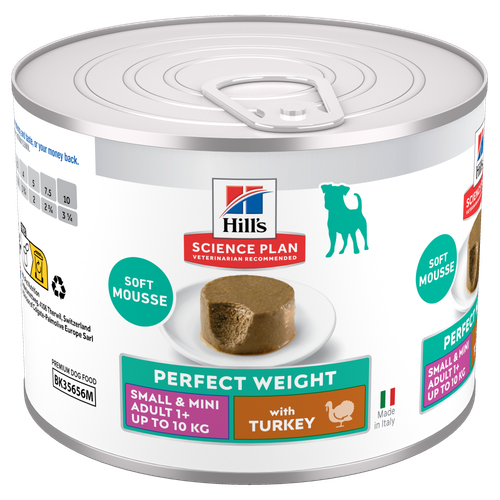 Perfect Weight Small & Mini Adult Dog Food
Perfect Weight Small & Mini Adult Dog FoodHill's Science Plan Adult Small & Mini Dog Food with Turkey is a complete premium pet food for adult small dogs from 1 year old that are prone to weight gain or slightly overweight. This deliciously smooth mousse is formulated to deliver the appropriate amount of energy to support weight maintenance in adult dogs.
Shop Now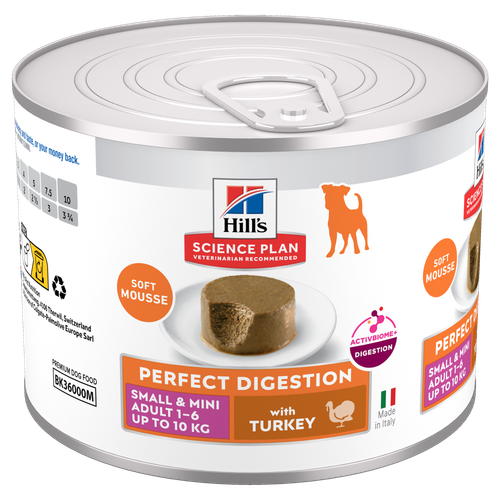 Perfect Digestion Small & Mini Adult Dog Food
Perfect Digestion Small & Mini Adult Dog FoodHill's Science Plan Perfect Digestion Small & Mini Adult Dog Food with Turkey is a complete premium pet food for small breed adult dogs aged 1–6 years. This deliciously smooth mousse is precisely balanced to deliver the appropriate amount of energy and to support digestive health in adult, small breed dogs.
Shop NowFeatured products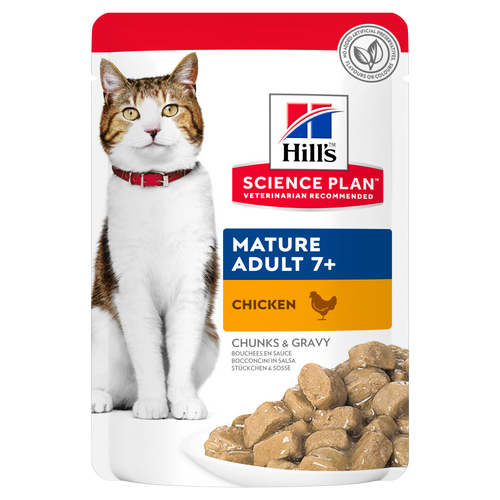 Mature Adult Wet Cat Food with Chicken
Mature Adult Wet Cat Food with Chicken
Tender chicken chunks in gravy for mature adult cats. Made with easy-to-digest ingredients, high-quality protein for lean muscle maintenance and antioxidant vitamins C+E for optimal health.
Shop Now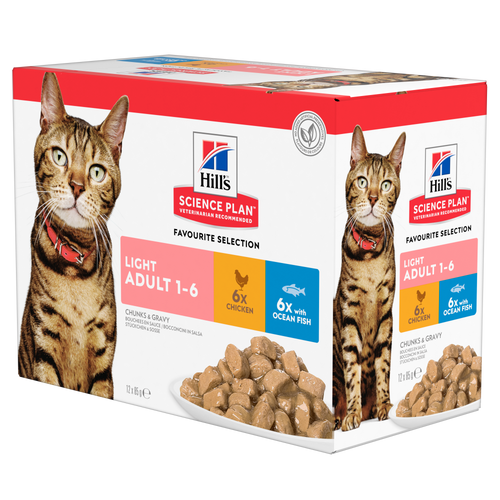 Light Adult Multipack Wet Cat Food with Chicken & Ocean Fish
Light Adult Multipack Wet Cat Food with Chicken & Ocean FishTender chicken chunks in gravy for cats, with L-carnitine and fewer calories for ideal weight management. Packed with high-quality protein, omega-6s, and vitamin E for shiny fur and healthy skin.
Shop Now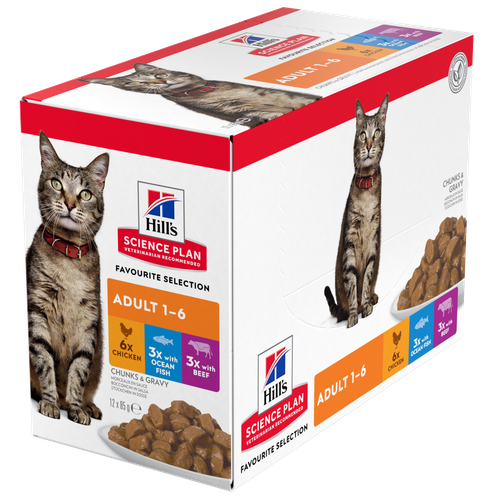 Adult Multipack Wet Cat Food with Beef, Ocean Fish & Chicken
Adult Multipack Wet Cat Food with Beef, Ocean Fish & ChickenTender chunks in gravy for cats, with high-quality protein to maintain lean muscle. With vitamin E and omega-3s & -6s for healthy skin and balanced minerals to support healthy vital organs.
Shop Now -
Dog
- Dog Tips & Articles
-
Health Category
- Weight
- Food & Environmental Sensitivities
- Urinary
- Digestive
- Joint
- Kidney
-
Life Stage
- Puppy Nutrition
- Adult Nutrition
- Senior Nutrition
Cat- Cat Tips & Articles
-
Health Category
- Weight
- Skin & Food Sensitivities
- Urinary
- Digestive
- Kidney
-
Life Stage
- Kitten Nutrition
- Adult Nutrition
Featured articles The Right Diet For Your Pet
The Right Diet For Your PetIn people, the right diet is very important. If you are eating the wrong way for your metabolism, activity level, age and lifestyle you could end up with health issues.
Read More Show some love with wet foods: a great choice for pets with health issues
Show some love with wet foods: a great choice for pets with health issuesShow some love with wet foods: a great choice for pets with health issues.
Read More The Incredible Science Behind Your Pet's Microbiome
The Incredible Science Behind Your Pet's MicrobiomeLearn what your pet's microbiome is, how it contributes to your pet's gut and overall health, and why nutrition is important in maintaining healthy microbiomes.
Read More -


Seeing the World Through a Small Dog's Eyes
First, try to get down on your dog’s level – literally – and take a good look around. This is your dog’s environment, so it’s important to see things from his perspective and ask yourself a few key questions: Do things look a little scarier from down here? Does the sofa loom high overhead? Does the slippery kitchen floor seem to extend for miles? When people and household objects tower above you, things can get a bit intimidating. Imagine a vacuum cleaner that’s bigger than you are to get an idea of how your dog may feel!
- How far away from primary rest or play areas are essentials such as the water dish? A short sprint or a marathon distance?
- If your dog is allowed on the furniture, how far do they have to jump? Would your dog benefit from a step that leads up to the couch or bed?
Small Breed Dogs: All Shapes & Sizes
Small, miniature and toy breeds are a celebration of the wide variety of the mini dog form: Some are compact and sturdy, like Jack Russell Terriers, French Bulldogs or West Highland White Terriers. Others, such as Italian Greyhounds, Prague Ratters and Chihuahuas, can be quite sensitive and delicate, naturally requiring gentle handling and careful treatment. There are several breeds that have very distinct features, such as the iconic long-backed Dachshund, round-headed Japanese Chin, or the hairless Chinese Crested.
Whatever your dog’s breed, it’s important to take their needs into account when considering things like the size and shape of their bed, size and placement of food and water dishes, lead, collar and/or harness type, temperature requirements, and more.
Small Dog Syndrome
Being a small dog in a big world can be a challenge. However, small dogs very often get away with naughty or dangerous behaviours that would never be tolerated in their larger-breed counterparts (also known as "small dog syndrome"). These little Napoleons often first use these behaviours as a kind of defence mechanism, but it can quickly turn to habit if not corrected early on. Owners should keep in mind that pulling on the lead, running away when called, snarling or biting are all equally bad behaviours, whether coming from a tiny Chihuahua or a great big Rottweiler. In both cases, the right socialisation and training can work wonders. Learning and practicing appropriate behaviour in a wide variety of situations from an early age will help a dog of any size feel reassured and relaxed, helping to prevent undesirable or even dangerous behaviours. Seek help from a reputable trainer who knows your breed, or search for a local group obedience class. Additionally, there are many books available to help you decode and correct your dog’s behaviour. If you need a recommendation or some extra support, don’t hesitate to contact your vet.


Tasty Tips
Food Requirements: Less Means More
Small breeds have different calorie requirements than large dogs. Since they have more surface area per kg than large dogs, they typically expend more energy for normal body functions like keeping warm. They also spend more energy on simply getting around. Walking down to the end of the street may cost your neighbour’s Labrador 100 steps, while your Lhasa Apso may need 400 to cover the same distance.
Small dogs may need more calories per kg daily than large dogs do, but they should still be safeguarded against gaining too much excess weight. Obesity is just as dangerous for small dogs as it is for big dogs.
Special Considerations for Puppies
These tiny tots need more calories per ounce of bodyweight. And because they can’t stockpile energy reserves in the way larger-breed pups can, they require more frequent calorie-dense meals. Mini-breed puppies should be fed small meals frequently throughout the day to compensate for their small stomach capacity and rapacious need for energy. Read pet food labels for optimal feeding amounts and ask your vet for advice tailored to your individual little puppies needs. As with any breed, small pups should be protected, but not treated like babies. Although it may take a strong heart to look a fluffy little Cavalier King Charles Spaniel puppy in its big brown eyes and say “No!”, it must be done. Early training for small-breed dogs sets the stage for a more relaxed, dependable and better-behaved canine companion later on.
Living Long and Well
Small dogs often live significantly longer than their large- and giant-breed counterparts. Maltese, Chihuahuas, Yorkshire Terriers and Miniature Dachshunds are all known to live past 12 years old. The median lifespan for Miniature Poodles and Border Terriers is nearly 14 years, but many have been known to reach nearly 20 years of age – venerable, to be sure! However, their lifespan will depend on a lot of individual variability and factors like health care, nutrition and environment. With such a long lifespan, often combined with city dwelling, small dogs need extra protection to maintain good health well into their golden years. In between regular trips to the vet, small dogs can really benefit from extra antioxidants to help their bodies combat the effects of ageing and urban life.
Feeding the Right Food
Little dogs can also benefit from foods with smaller kibble size, making it easy for them to pick up and chew.
Look for a nutritionally complete food with antioxidants, omega 3 and 6 fatty acids and, of course, a tempting taste to help give your canine friend everything he needs for a happy, healthy life. A wide range of Science Diet and Prescription Diet foods are available to provide optimal nutrition to small dogs of all breeds and life stages.


One of our staff authors prepared this article for you
Related products
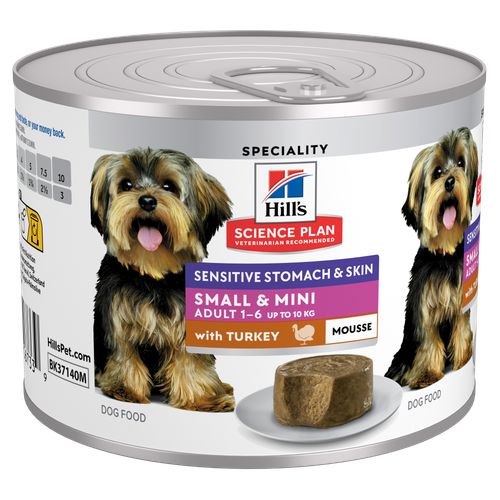
Hill's Science Plan Sensitive Stomach and Skin Small & Mini Adult Dog Food with Turkey is a complete premium pet food for small breed adult dogs aged 1–6 years. This deliciously soft mousse is enriched with ingredients that support digestive health & skin care.

Hill's Science Plan Perfect Digestion Small & Mini Adult Dog Food with Turkey is a complete premium pet food for small breed adult dogs aged 1–6 years. This deliciously smooth mousse is precisely balanced to deliver the appropriate amount of energy and to support digestive health in adult, small breed dogs.

Hill's Science Plan Sensitive Stomach & Skin Adult Wet Dog Food with Chicken is a complete premium dog food for adult dogs from 1 year. This savoury tinned loaf is enriched with ingredients that support digestive health & skin care.

Hill's Science Plan Adult Small & Mini Dog Food with Turkey is a complete premium pet food for adult small dogs from 1 year old that are prone to weight gain or slightly overweight. This deliciously smooth mousse is formulated to deliver the appropriate amount of energy to support weight maintenance in adult dogs.
Related articles

Learn effective tips for feeding a dog that's a picky eater and ensure proper nutrition for a finicky eater. Discover tips for pet parents at Hill's Pet UK.

How, when and what to feed your new puppy is an important decision, learn more about the things to consider for feeding your puppy.

Many human foods are dangerous to dogs. Read about 5 of the worst toxic food offenders that can kill your dog - and how much it takes to hurt them.

Learn about the potential health risks of a raw diet for dogs and why they aren't the best option for your pup or you.

Put your dog on a diet without them knowing
Our low calorie formula helps you control your dog's weight. It's packed with high-quality protein for building lean muscles, and made with purposeful ingredients for a flavourful, nutritious meal. Clinically proven antioxidants, Vitamin C+E, help promote a healthy immune system.
Put your dog on a diet without them knowing
Our low calorie formula helps you control your dog's weight. It's packed with high-quality protein for building lean muscles, and made with purposeful ingredients for a flavourful, nutritious meal. Clinically proven antioxidants, Vitamin C+E, help promote a healthy immune system.

